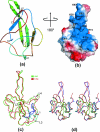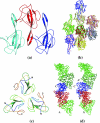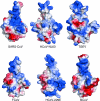Ribonucleocapsid formation of severe acute respiratory syndrome coronavirus through molecular action of the N-terminal domain of N protein
- PMID: 17229691
- PMCID: PMC1866093
- DOI: 10.1128/JVI.02236-06
Ribonucleocapsid formation of severe acute respiratory syndrome coronavirus through molecular action of the N-terminal domain of N protein
Abstract
Conserved among all coronaviruses are four structural proteins: the matrix (M), small envelope (E), and spike (S) proteins that are embedded in the viral membrane and the nucleocapsid phosphoprotein (N), which exists in a ribonucleoprotein complex in the lumen. The N-terminal domain of coronaviral N proteins (N-NTD) provides a scaffold for RNA binding, while the C-terminal domain (N-CTD) mainly acts as oligomerization modules during assembly. The C terminus of the N protein anchors it to the viral membrane by associating with M protein. We characterized the structures of N-NTD from severe acute respiratory syndrome coronavirus (SARS-CoV) in two crystal forms, at 1.17 A (monoclinic) and at 1.85 A (cubic), respectively, resolved by molecular replacement using the homologous avian infectious bronchitis virus (IBV) structure. Flexible loops in the solution structure of SARS-CoV N-NTD are now shown to be well ordered around the beta-sheet core. The functionally important positively charged beta-hairpin protrudes out of the core, is oriented similarly to that in the IBV N-NTD, and is involved in crystal packing in the monoclinic form. In the cubic form, the monomers form trimeric units that stack in a helical array. Comparison of crystal packing of SARS-CoV and IBV N-NTDs suggests a common mode of RNA recognition, but they probably associate differently in vivo during the formation of the ribonucleoprotein complex. Electrostatic potential distribution on the surface of homology models of related coronaviral N-NTDs suggests that they use different modes of both RNA recognition and oligomeric assembly, perhaps explaining why their nucleocapsids have different morphologies.
Figures




References
-
- Calvo, E., D. Escors, J. A. Lopez, J. M. Gonzalez, A. Alvarez, E. Arza, and L. Enjuanes. 2005. Phosphorylation and subcellular localization of transmissible gastroenteritis virus nucleocapsid protein in infected cells. J. Gen. Virol. 86:2255-2267. - PubMed
-
- Chang, C. K., S. C. Sue, T. H. Yu, C. M. Hsieh, C. K. Tsai, Y. C. Chiang, S. J. Lee, H. H. Hsiao, W. J. Wu, C. F. Chang, and T. H. Huang. 2005. The dimer interface of the SARS coronavirus nucleocapsid protein adapts a porcine respiratory and reproductive syndrome virus-like structure. FEBS Lett. 579:5663-5668. - PMC - PubMed
-
- Davies, H. A., R. R. Dourmashkin, and R. MacNaughton. 1981. Ribonucleoprotein of avian infectious bronchitis virus. J. Gen. Virol. 53:67-74. - PubMed
Publication types
MeSH terms
Substances
Associated data
- Actions
- Actions
Grants and funding
LinkOut - more resources
Full Text Sources
Other Literature Sources
Molecular Biology Databases
Miscellaneous

